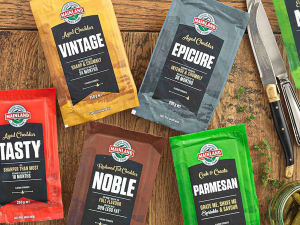Revamped Fonterra to be ‘more capital-efficient’
Fonterra chair Peter McBride says the divestment of Mainland Group is their last significant asset sale and signals the end of structural changes.
 Despite owning iconic brands like Mainland, Fonterra has been unable to compete in the global consumer market.
Despite owning iconic brands like Mainland, Fonterra has been unable to compete in the global consumer market.
OPINION: Fonterra's sale of its consumer dairy business to Lactalis is a clear sign of the co-operative’s failure to compete in the branded consumer market.
Despite owning iconic New Zealand brands like Anchor, Mainland, and Perfect Italiano, Fonterra has been unable to compete in the global consumer market. The loss to foreign ownership of these well-known local brands is a tough pill to swallow for New Zealand consumers, but it highlights a reality: the small markets of New Zealand and Australia could never match the scale and reach of Lactalis and other dairy giants such as Danone and Nestlé.
The reality is that consumer sales were always a minor part of Fonterra’s business, making up less than 10% of its NZ$25 billion annual revenue. Most of its business is in ingredients and foodservice. By contrast, Lactalis earns the majority of its €30.3 billion (NZ$55.1 billion) turnover from global consumer brands including Président, launched in 1968, Galbani, founded in 1882, and Parmalat, established in 1961. The company operates more than 260 factories worldwide and sells its brands in more than 90 countries.
The contrast is not only about scale but also about history. Lactalis’s flagship brands have been building consumer loyalty for decades, in some cases for more than a century. Lactalis itself was founded in 1932. Fonterra, by comparison, was only formed in 2001 through the merger of New Zealand’s dairy co-operatives and the Dairy Board.
In consumer branding terms, Fonterra entered the game late, facing competitors with much longer legacies and deeper roots in global markets. Anchor is its most recognised global brand, inherited from the New Zealand Dairy Board, and has existed since 1886. However, Fonterra has struggled to take the brand beyond Australasia, Britain and some select Asian countries.
Fonterra’s core business has always been in dairy ingredients, processing around 16 billion litres of milk each year. Competing in the consumer market, where margins are thin, marketing costs are high, and brand loyalty is deeply entrenched, has drained Fonterra’s resources and attention. Lactalis, however, has long been structured to succeed in this space.
For Fonterra, exiting consumer brands is a strategic move back to its strengths. For Lactalis, the acquisition adds trusted Australasian names to a strong portfolio of established brands in North America and Europe.
Dr Nic Lees is senior lecturer – Agribusiness Management, Lincoln University
When American retail giant Cosco came to audit Open Country Dairy’s new butter plant at the Waharoa site and give the green light to supply their American stores, they allowed themselves a week for the exercise.
Fonterra chair Peter McBride says the divestment of Mainland Group is their last significant asset sale and signals the end of structural changes.
Thirty years ago, as a young sharemilker, former Waikato farmer Snow Chubb realised he was bucking a trend when he started planting trees to provide shade for his cows, but he knew the animals would appreciate what he was doing.
Virtual fencing and herding systems supplier, Halter is welcoming a decision by the Victorian Government to allow farmers in the state to use the technology.
DairyNZ’s latest Econ Tracker update shows most farms will still finish the season in a positive position, although the gap has narrowed compared with early season expectations.
New Zealand’s national lamb crop for the 2025–26 season is estimated at 19.66 million head, a lift of one percent (or 188,000 more lambs) on last season, according to Beef + Lamb New Zealand’s (B+LNZ) latest Lamb Crop report.
President Donald Trump’s decision to impose tariffs on imports into the US is doing good things for global trade, according…
Seen a giant cheese roll rolling along Southland’s roads?